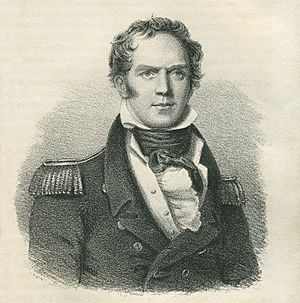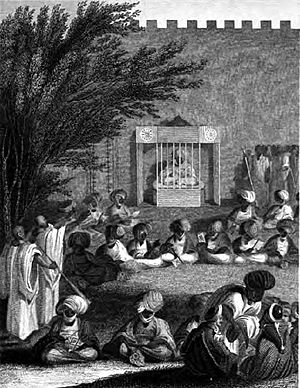Hugh Clapperton facts for kids
Hugh Clapperton (born May 18, 1788 – died April 13, 1827) was a Scottish naval officer. He became a famous explorer of West and Central Africa. He made important journeys into parts of Africa that Europeans had not seen before.
Contents
Clapperton was born in Annan, Dumfriesshire, Scotland. His father, George Clapperton, was a surgeon. Hugh learned about math and navigation from a young age.
When he was thirteen, he started working on a ship. This ship traveled between Liverpool and North America. After several trips across the Atlantic Ocean, he joined the navy. He quickly became a midshipman.
During the Napoleonic Wars, he was very active in the navy. In November 1810, he was part of the attack on Port Louis, Mauritius. He was one of the first to enter the area and took down the French flag.
In 1814, Clapperton went to Canada. He was promoted to lieutenant. He commanded a schooner, which is a type of sailing ship, on the Canadian lakes. In 1817, he returned home. In 1820, he moved to Edinburgh. There, he met Walter Oudney, who sparked his interest in exploring Africa.
First African Expedition
The British government wanted to explore the country of Bornu. This was after an earlier trip by Lieutenant George Francis Lyon was not successful. Walter Oudney was chosen to go to Bornu as a consul. Hugh Clapperton joined him on this important journey.
They left Tripoli in early 1822 and traveled south to Murzuk. Major Dixon Denham joined them there. On November 29, 1822, they continued their journey south from Murzuk.
On February 17, 1823, the group reached Kuka. This was the capital of the Bornu Empire in what is now Nigeria. They were welcomed by the sultan, Sheikh al-Kaneimi. They were also the first white men to see Lake Chad.
While in Kuka, Clapperton and Oudney decided to explore the Niger River. Denham stayed behind to map areas around Lake Chad. Sadly, only a few weeks later, Oudney died in a village near Katagum.
Clapperton bravely continued his journey alone. He traveled through Kano to Sokoto. This was the capital of the Fulani Empire. The Sultan, Muhammed Bello, made him stop there. The Niger River was only five days away.
Tired from his long travels, Clapperton returned to Kuka. He went through Zaria and Katsina. Denham found him looking very weak. Clapperton and Denham left Kuka for Tripoli in August 1824. They arrived in Tripoli on January 26, 1825. They then traveled to England, arriving on June 1, 1825. They were welcomed as heroes.
An account of their travels was published in 1826. It was called Narrative of Travels and Discoveries in Northern and Central Africa in the years 1822–1823 and 1824.
Second African Expedition and Death
After returning to England, Clapperton was promoted to commander. He was sent on another expedition to Africa. Sultan Bello of Sokoto had said he wanted to trade with the west coast.
Clapperton sailed on HMS Brazen. He landed at Badagry in the Bight of Benin. He started his overland journey towards the Niger River on December 7, 1825. He was joined by his servant Richard Lemon Lander, Captain Pearce, and Dr. Morrison. Sadly, Pearce and Morrison died of fever within the first month.
Clapperton continued his journey. He passed through the Yoruba country. In January 1826, he crossed the Niger River at Bussa. This was the same place where Mungo Park had died twenty years earlier.
In July, Clapperton reached Kano. He then went to the Fulani capital, Sokoto. He wanted to continue to Bornu to see Sheikh al-Kaneimi again. However, the Fulani were fighting al-Kaneimi. Sultan Bello would not let Clapperton leave.
After many months, Clapperton became very ill. He suffered from malaria, sadness, and dysentery. He died on April 13, 1827. His servant, Lander, was the only survivor of the expedition. Lander returned to the coast. By chance, he met Dixon Denham at Fernando Po. Denham then shared the sad news of Clapperton's death in London.
Clapperton's Legacy
Hugh Clapperton was the first European to share detailed information about the Hausa states. He visited them soon after the Fulani people established the Sokoto Caliphate.
In 1829, Clapperton's book, Journal of a Second Expedition into the Interior of Africa, &c., was published after his death. It included a short biography written by his uncle. Richard Lander, who brought back Clapperton's journal, also published his own book. It was called Records of Captain Clapperton's Last Expedition to Africa ... with the subsequent Adventures of the Author (1830).
Paintings and Engravings
A painting of Hugh Clapperton was made around 1817 by Sir Henry Raeburn. This painting is now in the United States. Another oil painting by Gildon Manton is kept at The National Gallery of Scotland.
The front page of Clapperton's book, Narrative of Travels and Discoveries in Northern and Central Africa, features an engraving by Thomas Goff Lupton.
Works by Clapperton
- Clapperton, H. (1826). Difficult and Dangerous Roads – Travels in Sahara and Fezzan, 1822–1825. Eds. Bruce-Lockhart, J. & Wright, J. Sickle Moon Books, London. ISBN: 978-1-900209-06-9
- Scans: Volume 1, Volume 2
See also
 In Spanish: Hugh Clapperton para niños
In Spanish: Hugh Clapperton para niños



